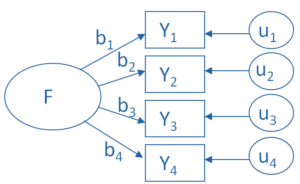by Maike Rahn, PhD
Rotations
An important feature of factor analysis is that the axes of the factors can be rotated within the multidimensional variable space. What does that mean?
Here is, in simple terms, what a factor analysis program does while determining the best fit between the variables and the latent factors: (more…)
Why use factor analysis?
Factor analysis is a useful tool for investigating variable relationships for complex concepts such as socioeconomic status, dietary patterns, or  psychological scales.
psychological scales.
It allows researchers to investigate concepts they cannot measure directly. It does this by using a large number of variables to esimate a few interpretable underlying factors.
What is a factor?
The key concept of factor analysis is that multiple observed variables have similar patterns of responses because they are all associated with a latent variable (i.e. not directly measured). (more…)
Before you run a Cronbach’s alpha or factor analysis on scale items, it’s generally a good idea to reverse code items that are negatively worded so that a high value indicates the same type of response on every item.
So for example let’s say you have 20 items each on a 1 to 7 scale. For most items, a 7 may indicate a positive attitude toward some issue, but for a few items, a 1 indicates a positive attitude.
I want to show you a very quick and easy way to reverse code them using a single command line. This works in any software. (more…)
Factor is confusing much in the same way as hierarchical and beta, because it too has different meanings in different contexts. Factor might be a little worse, though, because its meanings are related.
In both meanings, a factor is a variable. But a factor has a completely different meaning and implications for use in two different contexts. (more…)
I recently received this question:
I have scale which I want to run Chronbach’s alpha on. One response category for all items is ‘not applicable’. I want to run Chronbach’s alpha requiring that at least 50% of the items must be answered for the scale to be defined. Where this is the case then I want all missing values on that scale replaced by the average of the non-missing items on that scale. Is this reasonable? How would I do this in SPSS?
My Answer:
In RELIABILITY, the SPSS command for running a Cronbach’s alpha, the only options for Missing Data (more…)

